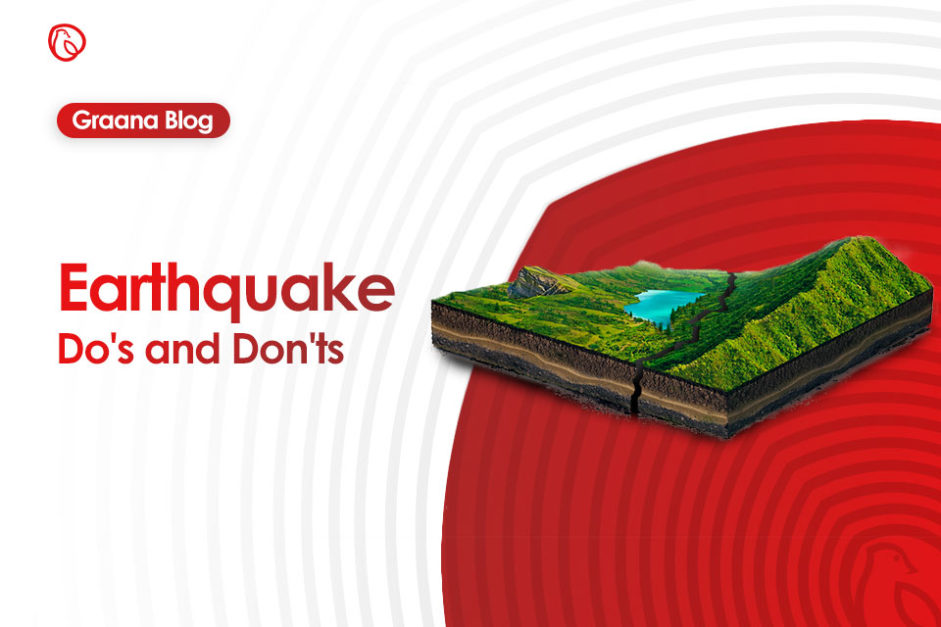
Taking into account the geology of Pakistan, the country encompasses land where both the Indian and Eurasian tectonic plates meet. Due to its placement, the country particularly susceptible to earthquakes. This makes Pakistan one of the most seismically active countries in the world, being crossed by several major fault lines. As a result of its placement on where the two tectonic plates collide, earthquakes in Pakistan occur often and are destructive.
Since Pakistan is in a region prone to earthquakes, it’s best to be prepared. Here are some steps that you can take before, during and after an earthquake to ensure your safety, and the safety of those around you.
1. Make a plan:
Earthquakes happen without any warning. However, one can always take certain steps to minimize the impact and damage incurred by the tremors. Preparedness starts with a plan, so for starters:
2. Educate yourself and your family members:
3. Check for hazards in your home:
4. Check the property you live in:
5. Bringing the community together:
It is important to bring the community together to help out in a state of emergency. It can minimize losses and damages as well. Since we live in a country that has so many fault lines, the neighbourhood needs to come together as soon as an emergency occurs.
When this calamity strikes, staying as safe as possible during the shocks should be your priority. Beware, because some earthquakes can actually be foreshocks due to the presence of our country on two tectonic plates and a bigger earthquake might occur. Wherever you are, minimise your movements to the few steps it will take you to get to a nearby safe place.
1. Drop, cover and hold on:
Drop where you are, onto your hands and knees. Make sure to cover your head and neck with your arms. If there is heavy furniture nearby, like a sturdy table or desk, crawl underneath it to protect yourself, but only if you can reach better cover without going through any danger or more debris. Remember to stay on your knees and bend over to protect vital organs from any injury.
In case of being on wheelchairs or are in a seated position, make sure to lock your wheelchairs and bend forward to cover your head with your arms, and hold on to your neck with both hands.
2. In case of debris, don’t run outside.
3. Don’t use the elevators.
4. If a desk or a table is unavailable, drop to the floor next to an interior wall and protect your head and neck.
5. If you’re in the bed, stay there and cover head with a pillow. Get out after the tremors stop.
6. Stand against the nearby wall, the centre of the building, or in a doorway.
7. Stand away from windows and outside doors.
1. Move away to an area that is clear of buildings, power lines, trees and other hazards.
2. If you’re driving, safely pull over to the side of the road. In case you can’t pull over, avoid overpasses, bridges, power lines, signboards, trees and other things that have a risk of collapsing on the vehicle.
If an earthquake had just recently happened, there is a serious chance of aftershocks, as well as other hazards such as damage to the building and houses, leaking gas and water lines, or suspended electricity.
1. Avoid damaged building:
2. Be careful of the debris:
3. Secure your home from damaged and hazardous conditions;
Earthquakes are a natural disaster that can happen quite suddenly and without warning. However, if we are well-prepared and keep a cool head, the loss and damage incurred in the event of an earthquake can greatly be reduced. We hope these tips will help keep you and your loved ones secure in the event of an earthquake. If you have any questions, or if there’s something you want to add to the discussions, please do a leave a message in the comment section below.
Karachi: Pakistan’s foreign exchange reserves held by the State Bank of Pakistan (SBP) rose by…
Islamabad – The Capital Development Authority (CDA) has formally approved the construction of the IBM…
ISLAMABAD – A meeting was held at the CDA headquarters under the chairmanship of Capital…
Lahore: The Lahore Development Authority (LDA) has secured approval for the construction of four new…
Islamabad: The Islamabad Chamber of Commerce and Industry (ICCI) has announced its plan to host…
ISLAMABAD: The Capital Development Authority (CDA) has reported significant progress in its citywide streetlight modernization…